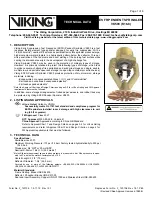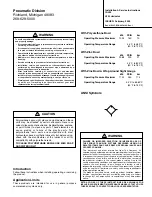
3
Notice to Installer
• Do not discard this manual after installation. This manual contains
important operation, maintenance and precautionary information .
Please present this manual to the user/owner/operator after
installation .
• It is strongly suggested that you read this manual before installing
system to ensure the best possible installation .
• Installation must comply with all local and state plumbing codes
and regulations .
• Connect the system to cold water supply only. Water Temperature
cannot exceed 100°F (38°C) .
• System must be installed in a vertical, upright and level position.
• Do not use with water that is microbiologically unsafe or of
unknown water quality .
• Notice to user/owner/operator: Please retain this manual for future
reference for parts, maintenance, or troubleshooting .
• It is recommended that all personnel responsible for operation and
maintenance of this product read the precautions, maintenance,
and operation sections of this manual .
Installation Precautions
• Do not install system on line pressure above the rated pressure as
noted in System Specifications above .
• Do not install the system on a hot water line. Failure to limit the
water temperature to 100°F (38
°
C) can result in housing failure and
property damage .
• Do not connect the system backwards with the feed water line
connected to the outlet .
• Do not use liquid pipe thread compounds for threaded
connections . Use Teflon
®
tape only .
• Do not solder plumbing connections that are attached to the
housings or inlet/outlet fittings . System damage may occur due to
high temperature .
• Do not allow the system to freeze. Turn off water supply and drain
the system if temperature falls below 32°F (0
°
C) .
• Do not install system in direct sunlight or where the system will be
exposed to harsh chemicals or may be subjected to being hit by
moving equipment, carts, mops, or any other item that may cause
damage .
• Allow 3" (76mm) minimum clearance under the housings for filter
replacement .
• If water hammer is evident, install water hammer arrestors before
the system .
• Do not over tighten fitting connections.
• Always back up valves and fittings with a wrench when installing
fittings to avoid over tightening or loosening existing fittings .
• Do not install the unit behind equipment where it may be difficult to
access the system for future filter replacements .
Position the system in a suitable location . The direction of flow
through the system is left to right . Keep this in mind when determin-
ing installation locations . Do not mount the system near any source
of heat . Also do not mount this system over anything that may be
adversely affected by water .
OneFlow Application Practices
Note: Systems using OneFlow technology prevent hardness related
scale formation inside the plumbing system at influent hardness
levels of 75 grains per gallon of calcium carbonate and less . Due to
variances in water chemistry certain aesthetic conditions external of
the plumbing system may not be attained . New copper lines need
to be passivized before placing unit into service. Copper usually
originates from new copper plumbing upstream of the OneFlow®
system . All new copper plumbing before the system should be al-
lowed to passivate by operating under normal conditions for a period
of 4 weeks prior to starting the system up . This will allow the copper
surfaces to be fully flushed and develop a natural protective surface .
To further minimize any problem with excess copper, avoid applying
excess flux on the inner surfaces of the pipe and use a low-corrosivi-
ty water soluble flux listed under the ASTM B813 standard . OneFlow
is not for use on closed loop systems .
Operation
With sufficient pressure, operation of this system is completely au to-
matic . Dependable operation involves only monitoring system pres-
sure differential, periodic filter changes, and service documentation .
Installation
* Please note: All cartridge filters are preinstalled, in the
housings, at the factory.
1 . Turn off all equipment to be fed by the system, locate the water
supply shutoff valve and turn it off .
2 . Apply Teflon tape to the threads of the inlet and outlet valve and
pressure gauge assemblies . Thread the inlet and outlet valve
and pressure gauge assemblies into the inlet and outlet of the
system . The valve and pressure gauge assembly with the ¼"
(8mm) Quick-Connect flush valve fitting is to be installed on the
outlet of the system .
See the drawings on page 4 and 5 of this manual for proper
valve and pressure gauge assembly placement .
NOTE: DO NOT OVER TIGHTEN THESE FITTINGS INTO THE
FILTER HEADS.
3 . Anchor the system on a wall stud or suitable mounting material
spanning wall studs . System must be vertical, upright and level .
4 . Run a suitable line from the tap water source to the inlet ball
valve on the left side of the system . Slimline systems require 3/8
"
(10mm) NPT fittings, Big Blue models require 3/4
"
(20mm) NPT
fittings . Brace the inlet ball valve on the system with a wrench
when connecting the feed water line .
NOTE: DO NOT
OVERTIGHTEN CONNECTION FITTING INTO BALL VALVE.
5. Select the appropriate size tubing for the equipment being fed,
and connect it to the outlet ball valve of the system .
NOTE: DO
NOT OVERTIGHTEN CONNECTION FITTING INTO BALL
VALVE.
6 . Install the ¼" (8mm) tubing into the Quick-Connect fitting on the
outlet of the system and hold it over a drain . Open the
1
⁄
4
" (8mm)
drain valve .
7 . Once all inlet and outlet piping has been completed check and
make sure all filter housing are tight, slowly open the inlet valve
and allow all air to purge from the system . Slowly close the
1
⁄
4
"
(8mm) drain valve, allow the system to reach operating pressure,
and check for leaks .
8 . If no leaks are present, open the
1
⁄
4
" (8mm) drain line again and
allow it to run to drain for 5 minutes to flush the system then
close the valve .
9 . Open the outlet water valve and check for leaks .
10 . Record the start up date and pressure gauge values in system
maintenance log .
Note: Overtightening components can damage the system
causing water damage and/or system failure.
Summary of Contents for Hydro-Safe Steam Max-S1
Page 6: ...Notes 6...
Page 7: ...Notes 7...


























